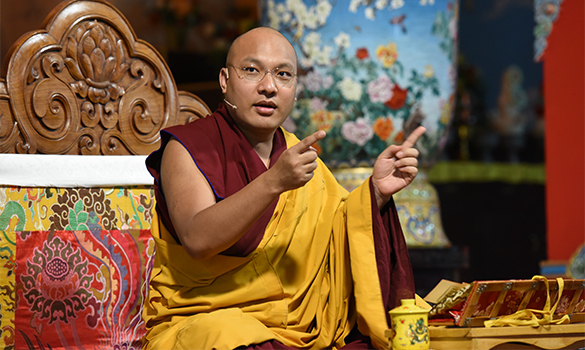
29 November, 2014 Tergar Monastery, Bodhgaya
In Session One, the text had spoken of the four ways in which students can serve the Lama. Today’s section began with examples of disciples who showed great devotion towards their Lamas and the benefits derived from this.
Jetsun Milarepa faced great hardship; he lived like a beggar in an isolated place with no one to share in either his happiness or his sorrows. However, as Dusum Khyenpa said, if you remember the qualities of the Lamas and supplicate them with great fervour, the power of the devotion and strength of the blessings is uninterrupted. For that reason Milarepa was able to stay in a remote place, in spite of all difficulties. “It’s like having an iron-rod of devotion in your heart,” explained the Karmapa.
Gyalwa Gotsangpa was another example of great devotion. He practised extremely hard in a cave in a cliff-face for twelve years, and made the commitment that the cave, the cliff and the person should become one. People could hear the echo of his supplications on the far side of the valley.
It is possible to supplicate the Gurus through physical postures; His Holiness read details of these from the text.
Sometimes, the Karmapa pointed out, people think that they only need to listen to instructions from the Guru once, but actually we need to listen to them over and over again, until they become a part of our being.
Mikyo Dorje’s text warns that without supplicating the Lamas, respecting their wishes, and practising with effort and devotion, our dharma practice will only accomplish the temporary things of this life.
The text now moves on to contemplate the precious human life, which is not merely a human life. In order to practice the Dharma, if we want to practice the entire path which will lead us to liberation and omniscience, the support is the precious human body with the eight leisures and ten resources. This is the definition of a precious human life.
To begin with, we need to appreciate how rare and difficult it is to achieve a precious human life which affords us this opportunity to practice the dharma. There are innumerable births in which it is not possible. It is more difficult to find a precious human life than “a star in the daytime”, or for a blind man to find a pin concealed in a haystack.
The eight leisures signify freedom from the obstacles which prevent us from practising the dharma, whereas the ten resources are all the facilities we need to accomplish our practice. Often we fail to appreciate the amazing opportunity that we have in this life to practise. Though we might find it difficult to think of hell beings or hungry ghosts, we can understand the limited capacity of animals, and also how barbarians and people with wrong views are prevented from practising.
Laying the text aside, His Holiness commented that people often think that outlying lands and barbarian lands are the same. Many presumed Tibet to be a central land, but as it lacks one of the four pillars –fully ordained nuns–Tibet is an outlying land. Consequently, you could end up saying that Tibetans are barbarians!
Across the world today there are many places of conflict or deprivation in the world where people lack the leisures and resources. Living in a war zone, all your energy would go into staying alive, let alone practising Dharma. In some parts of the world, many had to live in great deprivation, not enough food or even water to drink; sometimes the only thing available to drink is the urine from oxen. In such a place, you would be focused on getting the bare necessities to stay alive not on dharma practice.
On one hand, we need to realise what a great opportunity we have and take responsibility to use it properly and make our precious human lives meaningful. On the other, we need to think compassionately of those who do not have such opportunities.
The Karmapa gave an heart-rending, true example: In Iraq there was a young girl, maybe five or six years old. She had no one. Her mother was dead. And so the little girl drew a large picture of her mother in the road outside her school. Placing her shoes outside the picture, she lay down on top of it, as if she were sleeping in her mother’s lap.
We need to understand that we already possess all that we need. If we follow our desires, he warned, they are endless and we will never be able to fulfil them: A wise man said, “Contentment is a jewel which is present naturally within us. It is not something that we buy from outside. If we know how to be content then we are rich. If we do not have contentment, no matter how many billions of dollars we have, inside we will feel like a beggar. We will feel like we never have enough. We will never think, ‘I’ve got what I need. I’ve got all the resources I need.’”
Addressing the monks specifically he compared the resources they had in India with those of a monk at Tsurphu, in Tibet. To begin with, a monk at Tsurphu had to build his own room, either from his own money or his family had to give him the money. Then he had to get his own food, and buy his own clothes. In India monasteries provide food, accommodation and clothing.
Monks in India had the leisures and the resources, so they should not let the opportunity go to waste. The Karmapa gave a final warning from the text:
“Accomplishing something for the purposes of this life is like eating poisoned food.”
History of the Debate Texts and Details of the Gampopa Conference
The final section of the afternoon was directed at the monks.
The Gyalwang Karmapa noted that this is the third and final year studying Collected Topics, Types of Evidence, and Types of Mind. The book on Types of Evidence and Types of Mind contains a text by Namgyal Drakpa.
The study book for Collected Topics has been published in three separate sections Beginning, Intermediate, and Advanced level. It is based on a root text by the Sixth Shamar Choekyi Wangchuk with a commentary written by His Holiness.
His Holiness went on to give details of the final part of the Gunchö, which will take the form of a four-day conference on Gampopa’s The Jewel Ornament of Liberation. Gampopa practised both streams of instruction from the Kadampa and the Mahamudra traditions, and the foundation of these instructions is contained in The Jewel Ornament of Liberation and The Precious Garland of the Supreme Path. The conference will continue for three years, so that the monks have the opportunity to fully appreciate this text which describes the stages of the path of the three different types of individual.
Nine scholars from the monastic colleges spent two months with the Karmapa at Gyuto researching and analysing. In the first instance the focus was on the different editions of the text. Many scholars say that the Yangpachen edition is the best, so this was taken as the basis, and compared with the other seven editions, including Derge and Bhutan. The team also researched the source of various citations, and completed a fair amount of analysis of the text.
As His Holiness explained, “This is a way in which those of us who follow the Dagpo Kagyu can repay the great kindness of Gampopa.”
There will be several papers presented at the conference, and the monks will be able to ask questions.


